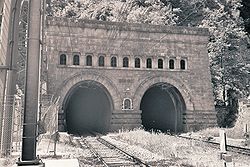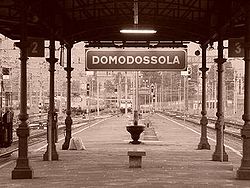- Milan–Domodossola railway
-
 Simplon Tunnel at the northern end of the line
Simplon Tunnel at the northern end of the line
 Domodossola station
Domodossola station Legend
Legend

To Zermatt/Lausanne 

To Bern via Lötschberg Base Tunnel 

To Bern via Lötschberg Tunnel 

Brig (SBB-CFF-FFS/MGB) 

To Disentis/Mustér via Furka Oberalp Bahn 



Simplon Tunnel (20 km)/ Italian–Swiss border 



Iselle Tunnel (169 m) 

0,00 Iselle 

Trasquera Tunnel (1.712 m) 

Varzo Spiral Tunnel (2.966 m) 

0,00 Varzo 

Varzo Tunnel (81 m) 

Mognatta Tunnel (422 m) 

Gabbio Mollo Tunnel (568 m) 

San Giovanni Tunnel (425 m) 

Rio Rido–Preglia Tunnel (2.266 m) 

0,00 Preglia 



0.00 Domodossola / To Locarno 

To Novara 


Toce River 





Domodossola line 

13,00 Vogogna Ossola 


16,00 Premosello 



20,00 Cuzzago 

To Novara 



27,00 Mergozzo 


30,00 Verbania-Pallanza 
Toce River 

35,00 Baveno 


39,00 Stresa 

45,00 Belgirate 
47,00 Lesa 
51,00 Meina 


Arona 
To Santhià, Novara 
61,00 Dormelletto 
From Novara 
Ticino River 
65,00 Sesto Calende 
From Luino 

Autostrada A8/A26—European route E62 
71,00 Vergiate 
75,00 Somma Lombardo 
78,00 Casorate Sempione 
From Luino 
From Varese and Porto Ceresio 
Gallarate 
89,00 Busto Arsizio 
FNM Saronno-Novara line 
94,00 Legnano 
97,00 Canegrate 
99,00 Parabiago 
104,00 Vanzago-Pogliano 
From Turin 
108,00 Rho 



Milan western ring road—European route E35–E62 






Autostrada A4—Strada Europea E64 
8+856 Rho Fiera Milano * 12.2008 
Autostrada A8 
116,00 Milano Certosa 
To Passante and Milano Porta Garibaldi 
Milan–Saronno railway 
Milan–Asso railway 
To Chiasso, Verona, Venice, Bologna and Genoa 
125,00 Milano Centrale The Domodossola–Milan railway line is a major Italian railway route and an important part of the European rail network. It is one of Italy's busiest lines for both passenger and freight trains. The line connects Milan and Domodossola with Brig, an important Swiss railway junction, via the Simplon Tunnel. Direct passenger trains run from Brig to Paris (via Lausanne), Geneva and Brussels (via Basel and Luxembourg). The line runs through lower Varese Province, the valley of Ossola and along the shore of Lake Maggiore.
History
The line was completed to Gallarate in the early 1860s and was extended over the Ticino River in 1882, reaching Domodossola in 1888. The Simplon Tunnel was completed and the line extended to it from Domodossola in 1906; it was duplicated in 1922.[1] It was part of the Società per le strade ferrate dell'Alta Italia (Upper Italian Railways) from 1865, the Società per le Strade Ferrate del Mediterraneo (Mediterranean Railway Company) from 1885 and Ferrovie dello Stato from 1905.
Route
The line is fully electrified at 3,000 volts DC and is double track. In some stretches between Arona and Domodossola, the two tracks are not adjacent: the southbound line towards Milan runs directly along the shore of Lake Maggiore; the northbound line towards Domodossola is located a little inland because of the local geography. At Domodossola the electrification system changes to the Swiss system of 15,000 volts AC 16.7 Hz for the Simplon Tunnel.
The regional passenger rail service is operated by Trenord. The section between Gallarate and Milan is also served by suburban line S5. The railway is also served by long distance Eurocity and EuroNight trains, as well as the high-speed Cisalpino trains, which connect Milan to the Swiss cities of Lausanne, Geneva, Bern and Basel.
The Domodossola–Milan line is also used by freight trains operated by Trenitalia Cargo, SBB Cargo Italia and other private companies.
The line passes through the metropolitan area to the north-west of Milan, across the plain towards Gallarate. It continues through the forests of lower Varese Province towards Lake Maggiore. After Sesto Calende it crosses the Ticino River on an iron bridge, which was opened to traffic in 1882. State Highway 33 (the Milan–Simplon Pass road) uses the same bridge, above the railway. From Arona, the line largely runs along the western shore of Lake Maggiore, keeping above the shore, passing through the major tourist town of Stresa. After Baveno, it enters the Toce plain and runs for about 30 km up the Ossola valley to Domodossola. It then approaches the Simplon Tunnel through nine tunnels including the 2,966 metre-long Varzo Tunnel, which is built as a spiral in order to gain height.
References
- ^ Kalla-Bishop, P. M. (1971). Italian Railways. Newton Abbott, Devon, England: David & Charles. p. 61.
Categories:- Railway lines in Italy
- Transport in Lombardy
- Transport in Piedmont
Wikimedia Foundation. 2010.
